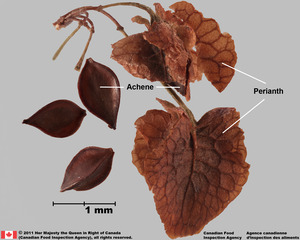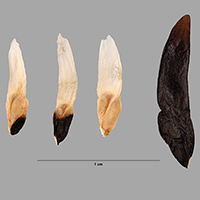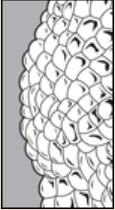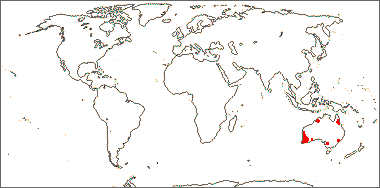Family name: Boryaceae M.W. Chase, Rudall & Conran
Synonym(s): [none]
Common name(s): borya family
*Number of genera/species: 2/12
List of genera records in GRIN-Global
seed
Fruit a loculicidalloculicidal:
type of capsular dehiscence, opening longitudinally through the locules (compare septicidal)
 capsulecapsule:
capsulecapsule:
a dry, dehiscent fruit derived from a compound ovary , 2.5–4.5 mm long, ovoidovoid:
, 2.5–4.5 mm long, ovoidovoid:
3D shape—ovate or fusiformfusiform:
or fusiformfusiform:
spindle-shaped; broadest at the middle and tapering at both ends , with few seeds, enclosed by persistent perianthperianth:
, with few seeds, enclosed by persistent perianthperianth:
collective term for calyx and corolla of a flower
 . Pericarppericarp:
. Pericarppericarp:
fruit wall or fruit coat
straw colored, smooth, sometimes with midline groove.
Seeds ellipsoidellipsoid:
3D shape—elliptic
to ovoidovoid:
3D shape—ovate , tereteterete:
, tereteterete:
approximately circular in cross section; width and thickness approximately equal
 or slightly compressedcompressed:
or slightly compressedcompressed:
flattened; in grasses, used to denote compression (not necessarily flattened) either laterally or dorsiventrally
, 0.8–1.2 mm long. Seed coat black, dulldull:
reflecting only a low proportion of incident light, with no apparent sheen , phytomelanphytomelan:
, phytomelanphytomelan:
carbonaceous, opaque material that usually covers the seed coat to give it a black appearance, common in certain monocot families encrusted, smooth or variously ornamented.
encrusted, smooth or variously ornamented.
Embryo very small, ovoidovoid:
3D shape—ovate , straight or curvedcurved:
, straight or curvedcurved:
(of embryo) linear embryo is curved into an arch or horseshoe with the ends far apart .
.
Endosperm copious without starch.
| Fruit | |
| Type | loculicidalloculicidal: type of capsular dehiscence, opening longitudinally through the locules (compare septicidal)  capsulecapsule: capsulecapsule:a dry, dehiscent fruit derived from a compound ovary  |
| Size range | 2.5–4.5 mm long |
| Shape(s) | ovoidovoid: 3D shape—ovate  , fusiformfusiform: , fusiformfusiform:spindle-shaped; broadest at the middle and tapering at both ends  |
| Surface relief | smooth, sometimes with midline groove |
| Color(s) | straw-colored |
| Unique features | Straw-colored ovoidovoid: 3D shape—ovate  or fusiformfusiform: or fusiformfusiform:spindle-shaped; broadest at the middle and tapering at both ends  capsulescapsule: capsulescapsule:a dry, dehiscent fruit derived from a compound ovary  with a few minute, black, phytomelan-encrusted seeds. with a few minute, black, phytomelan-encrusted seeds. |
| Seed | |
| Size range | 0.8–1.2 mm long |
| Shape(s) | ellipsoidellipsoid: 3D shape—elliptic , ovoidovoid: 3D shape—ovate  |
| Surface relief | smooth, papillatepapillate: surface relief—bearing minute, distinct, broad-based projections, tapering to a rounded apex  , striatestriate: , striatestriate:surface relief—having fine, parallel lines, grooves or ridges  , wartywarty: , wartywarty:surface relief—distinct, rounded projections that are large relative to the fruit size; tuberculate, verrucose  , alveolatealveolate: , alveolatealveolate:surface relief—reticulated, honeycombed; ridges that intersect to form polygonal cells with a regular size and shape similar to a honeycomb  , colliculatecolliculate: , colliculatecolliculate:surface relief—covered with small, round projections, similar to blistered  , sculptured , sculptured |
| Color(s) | black |
| Unique features | Minute, dulldull: reflecting only a low proportion of incident light, with no apparent sheen  , black seeds with phytomelanphytomelan: , black seeds with phytomelanphytomelan:carbonaceous, opaque material that usually covers the seed coat to give it a black appearance, common in certain monocot families  and very small embryos. and very small embryos. |
| Other | |
| Embryo | ovoidovoid: 3D shape—ovate  , straight or curvedcurved: , straight or curvedcurved:(of embryo) linear embryo is curved into an arch or horseshoe with the ends far apart  |
| Nutritive tissue | endosperm copious without starch |
Australia.

Distribution map courtesy of Angiosperm Phylogeny Website.
Baskin and Baskin 2021Baskin and Baskin 2021:
Baskin C and Baskin J. 2021. Relationship of the lateral embryo (in grasses) to other monocot embryos: A status up-grade. Seed Science Research 31 (3): 199-210. doi:10.1017/S0960258521000209; Barrett 2018Barrett 2018:
Barrett MD. 2018. Three new species of Asparagales from the Kimberley region of Western Australia. Telopea: Journal of Plant Systematics 21: 25-37.; Dahlgren et al. 1985Dahlgren et al. 1985:
Dahlgren RMT, Clifford HT, and Yeo PF. 1985. The families of the monocotyledons: structure, evolution, and taxonomy. Springer-Verlag, Berlin. 520 pp.; Flora of Australia 2021+Flora of Australia 2021+:
Flora of Australia. Australian Biological Resources Study, Canberra. Accessed January 2021–March 2024. URL: http://www.ausflora.org.au; Kirkbride et al. 2006Kirkbride et al. 2006:
Kirkbride JH, Jr, Gunn CR, and Dallwitz MJ. 2006. Family guide for fruits and seeds, vers. 1.0. Accessed September 2020-January 2022. URL: https://nt.ars-grin.gov/seedsfruits/keys/frsdfam/index.cfm .; Kubitzki et al. 1990+Kubitzki et al. 1990+:
Kubitzki K et al., eds. 1990+. The families and genera of vascular plants. 7+ vols. Berlin etc.; PlantNET 2021+PlantNET 2021+:
PlantNET (The NSW Plant Information Network System). 2021+. Royal Botanic Gardens and Domain Trust, Sydney. Accessed January 2021–March 2024. URL: https://plantnet.rbgsyd.nsw.gov.au; Western Australian Herbarium 1998+Western Australian Herbarium 1998+:
Western Australian Herbarium. 1998+. Florabase—the Western Australian Flora. Department of Biodiversity, Conservation and Attractions. Accessed January 2021–April 2024. URL: https://florabase.dpaw.wa.gov.au/
*The number of genera and species is based on Christenhusz and Byng 2016Christenhusz and Byng 2016:
Christenhusz MJM and Byng JW. 2016. The number of known plant species in the world and its annual increase. Phytotaxa 261 (3): 201-217. https://doi.org/10.11646/phytotaxa.261.3.1, which may differ from the number of genera in GRIN-Global.